DAMITT 2020 Report: Antitrust merger enforcement trends amid the pandemic, U.S. elections and Brexit
Fast Facts

United States
- In 2020, the U.S. antitrust agencies concluded the second-highest number of significant U.S. merger investigations over the past decade, tied with the Obama administration’s final year at 33.
- Under the Trump administration, the U.S. agencies filed complaints seeking to block mergers at a record pace, with eight significant investigations concluded in 2020 resulting in litigation – the most for any year in DAMITT’s ten-year history.
- Despite the COVID-19 pandemic, the average duration of significant investigations decreased year-over-year for only the second time in DAMITT’s ten-year history to 11.4 months in 2020. But the year ended on a slow note as significant investigations concluded in Q4 2020 spiked to an average of 13.5 months.
- The gap in duration between significant investigations led by the DOJ and FTC largely disappeared in 2020 after a record four-month disparity in 2019.
- The Biden administration can be expected to implement policy changes at the DOJ over the next year, but the FTC currently has a 2-2 split between Democrats and Republicans and may not see significant enforcement changes until new Democratic commissioners are nominated and confirmed.
Europe
- The number of significant EU investigations remained steady in 2020, tied with the total of 19 significant investigations in 2019.
- The average duration was mixed in 2020 compared to 2019. Phase II investigations were completed in an average of 14.9 months, eight percent faster than in 2019. But Phase I remedy cases had an average duration of 9.5 months, a 24 percent increase in duration.
- The impact of EU General Court’s annulment of the EU Commission’s decision to block the Three/O2 merger (Hutchison case), and in particular the higher standard the EU Commission must meet to discharge its burden of proof could lead to more intense merger reviews and a corresponding increase in the duration of investigations.
- Brexit did not affect the EU Merger Regulation initially in January 2020, but the expiry of the post-Brexit transition period at the end of the year means that UK revenues will no longer be taken into account under the EU Merger Regulation going forward. The EU Commission will experience a slight downturn in the number of filings (estimated 15 percent), but the UK’s Competition & Markets Authority is likely to see a spike in activity levels (estimated over 50 percent).
The Dechert Antitrust Merger Investigation Timing Tracker (DAMITT) is a quarterly release from Dechert LLP’s Antitrust/Competition practice reporting on trends in significant merger control investigations in the United States (U.S.) and European Union (EU).
In the U.S., “significant” merger investigations include Hart-Scott-Rodino (HSR) Act reportable transactions for which the result of the investigation by the Federal Trade Commission (FTC) or the Antitrust Division of the Department of Justice (DOJ) is a consent order, a complaint challenging the transaction, an official closing statement by the reviewing antitrust agency, or the abandonment of the transaction with the antitrust agency issuing a press release.
In light of the procedural differences between the EU and U.S., DAMITT defines “significant” EU merger investigations to include transactions subject to the EU Merger Regulation and resulting in either a Phase I remedy or the initiation of a Phase II investigation.
DAMITT calculates the durations of significant investigations in both jurisdictions from the deal announcement date until the completion of the investigation, and therefore includes the time attributable to pre-notification consultation efforts.
Average Duration of Significant U.S. Merger Investigations Decreases in 2020
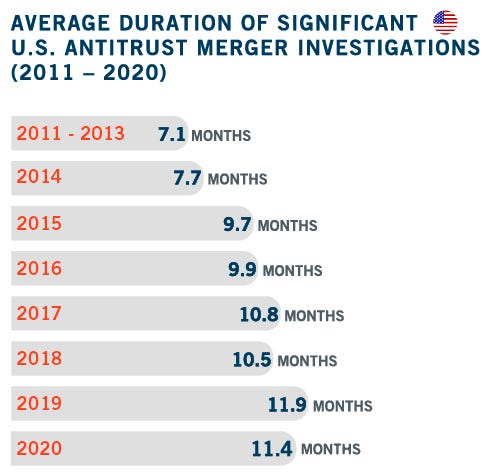
Even with the COVID-19 pandemic and a shift to remote work, the average duration of a significant investigation from deal announcement to the end of the investigation decreased to 11.4 months in 2020, down from the record high of 11.9 months in 2019. This is only the second time the average duration has declined over the 2011-2020 period tracked by DAMITT. As an exception, the average duration of a significant investigation spiked to an average of 13.5 months in the fourth quarter of 2020. DAMITT will continue to monitor whether this fourth quarter spike is a blip or a sign of a new trend.
Despite the decrease from 2020, the results provide a mixed final verdict on Trump administration efforts to reverse the trend toward longer significant investigations.
Overall, the average duration increased by 15 percent between 2016 and 2020. This was a slower rate of growth than in the final four years of the Obama administration, but it falls short of the ambitious goals set forward by both agencies early in the Trump administration.
The median significant investigation duration for 2020 was 10.4 months, an increase from the 9.8-month median in 2019 and a DAMITT record high.
Unlike 2019, when the disparity between the average and median durations saw a record high, the average and median durations are significantly closer in 2020, reflecting fewer significant investigations drifting far above the average. In 2019, for example, more than 30 percent of significant merger investigations lasted more than 13 months. In 2020, by contrast, less than 19 percent of significant mergers investigations lasted more than 13 months.
Large Gap in Average Duration of DOJ and FTC Significant U.S. Merger Investigations Closed in 2020
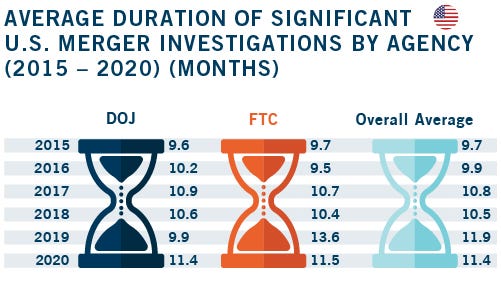
In 2019, DAMITT noted a lengthy four-month difference between the average durations of significant merger investigations led by the DOJ and FTC. In 2020, that disparity nearly disappeared.
Despite the greater number of significant merger investigations handled by FTC staff in 2020, the average duration of FTC significant investigations (11.5 months) nearly equaled the average duration of those led by DOJ (11.4 months). This marks a return to historical norms where the gap in average durations between the two agencies was consistently less than one month.
Third Longest Average Durations of Both Phase II and Phase I Remedy EU Investigations Over the Past Decade
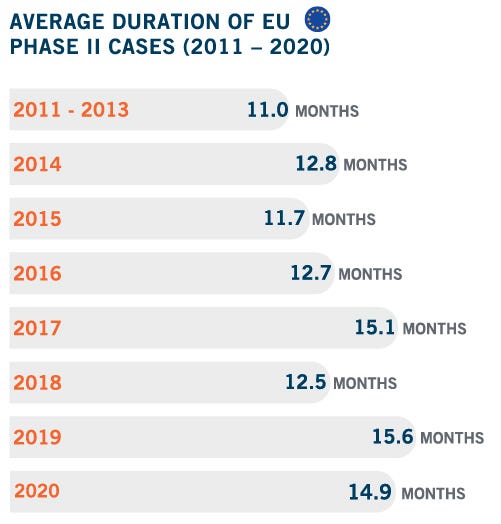
The average durations of both Phase I remedy and Phase II proceedings concluded in 2020 ranked as the third longest average duration for each category in DAMITT’s ten-year history. Phase II proceedings averaged 14.9 months in 2020, below the 2019 average of 15.6 months but still more than two months longer than the 2011-2019 annual average of 12.5 months. Phase I remedy cases lasted an average of 9.5 months, nearly 25 percent longer than the 2019 average of 7.7 months.
EU Phase II Proceedings
Phase II proceedings resolved in 2020 averaged 14.9 months, five percent faster than the 2019 average of 15.6 months, but still nearly 20 percent above the annual average since DAMITT started tracking the data in 2011.
As observed in the DAMITT Q3 2020 report, this high average is largely attributable to two exceptionally lengthy investigations, the Boeing/Embraer investigation which had already run for 22.4 months at the time it was abandoned and the PKN Orlen/Grupa Lotos investigation which was resolved after 16.8 months, making them the third and tenth longest investigations, respectively, since DAMITT started tracking in 2011. The exclusion of those two investigations brings the average duration down to 12.6 months.
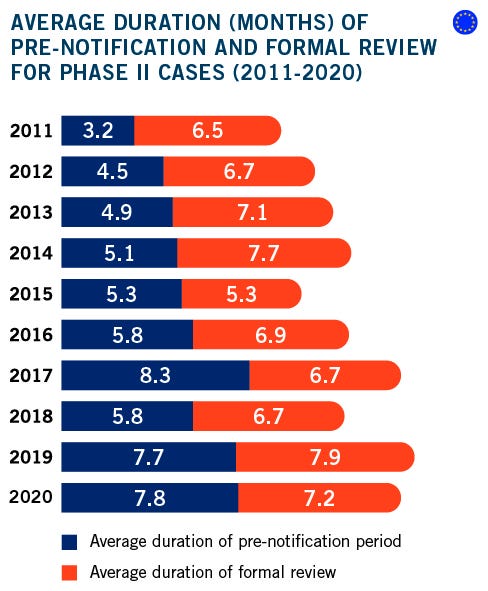
Unlike past years, the decrease in the average duration of Phase II investigations is entirely attributable to a decrease in the duration of the formal review period, going from 7.9 months in 2019 to 7.2 months in 2020. This shortened duration is linked to the EU Commission’s decreased use of its statutory powers under the EU Merger Regulation to agree to “voluntary” extensions of time with the merging parties and issue “stop the clock” orders. Voluntary extensions were granted in only 83 percent of cases resolved in 2020, whereas in 2019 all significant investigations included such extensions. Similarly, only 50 percent of the significant investigations resolved in 2020 were suspended following “stop the clock” orders, down from 78 percent in 2019. The concern that the EU Commission would increase its reliance on statutory tools to extend the review period in view of the COVID-19 pandemic has not materialized.
The average duration of the pre-notification periods for Phase II investigations shows only a minor increase in 2020, going from 7.7 months in 2019 to 7.8 months in 2020. But this average continues the upward trend observed since 2011. As explained in more depth in the DAMITT Q3 2019 report, pre-notification contacts have been a longstanding feature of EU merger reviews: merging parties invariably institute pre-filing talks with DG Competition staff very shortly after transaction announcement, if not before. The uptick in the period between announcement and notification is mostly explained by the EU Commission’s increased focus on internal company documents, which has contributed to merging parties spending more time and resources on pre-filing contacts.
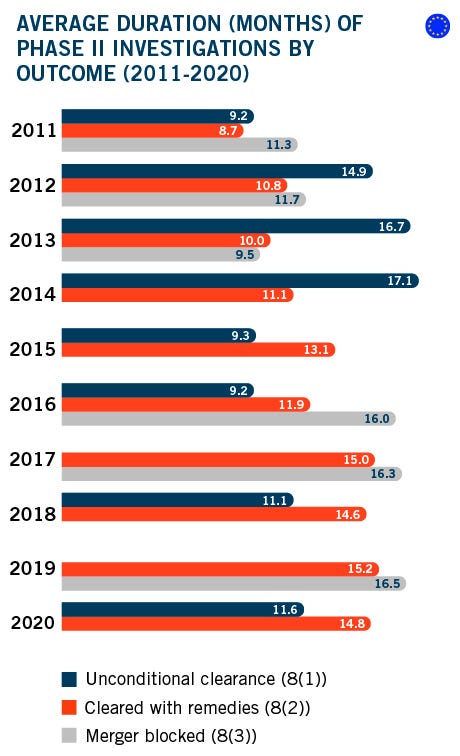
A closer examination of the average duration of investigations by type of outcome reveals that, although investigations resolved with unconditional clearances before 2015 tended to last longer than those that were blocked or cleared conditionally, post-2015 investigations show a reversal of this trend.
The May 2020 ruling of the EU General Court’s in the Hutchison case (T-399/16, CK Telecoms UK Investments v Commission) may further increase the duration of merger reviews, especially Phase II investigations. The EU Commission decided to block the acquisition of Telefónica UK by Hutchison 3G UK, which would have reduced the number of mobile network operators from four to three. For that reason the EU Commission found that the deal would have eliminated an important competitive force and likely led to price increases. The EU General Court held, inter alia, that the EU Commission did not establish with a sufficiently high degree of probability that Telefonica UK was an important competitive force and that the transaction would give rise to a significant impediment to effective competition. The judgment raises the evidentiary standard the EU Commission must meet to discharge its burden of proof. This higher standard may lead to more intense merger reviews and a corresponding increase in the duration of investigations.
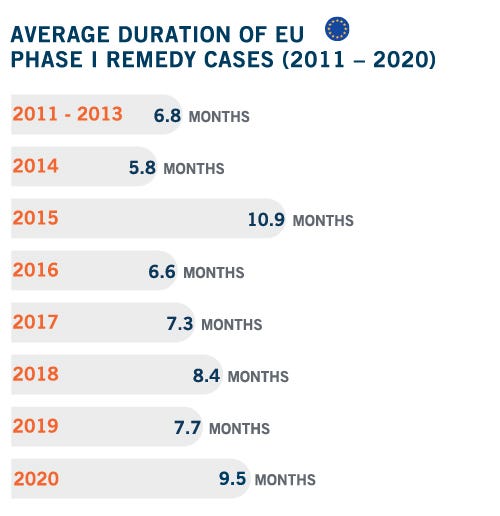
EU Phase I Remedy Cases
Phase I remedy cases concluded in 2020 lasted 9.5 months on average, up nearly 25 percent from the 2019 average of 7.7 months. The 2020 average is also well above the 7.5-month average observed over the 2011-2019 period tracked by DAMITT.
Contrary to what we observed for Phase II cases, the increased duration of Phase I remedy cases is driven by the increased duration of pre-filing talks. The average duration from announcement to notification in Phase I with remedy cases increased from 5.9 months in 2019 to 7.8 months in 2020, with the duration of the formal review period remaining in line with previous years.
Although the EU Commission hinted back in Q1 2020 that merging companies may increasingly use pull-and-refiles, only one Phase I remedy case resolved in 2020 featured a pull-and-refile, whereas two cases involved the use of this tool in each of the three previous years.
Total Significant U.S. Merger Investigations in 2020 Matched 2016, the Last Year of the Obama Administration
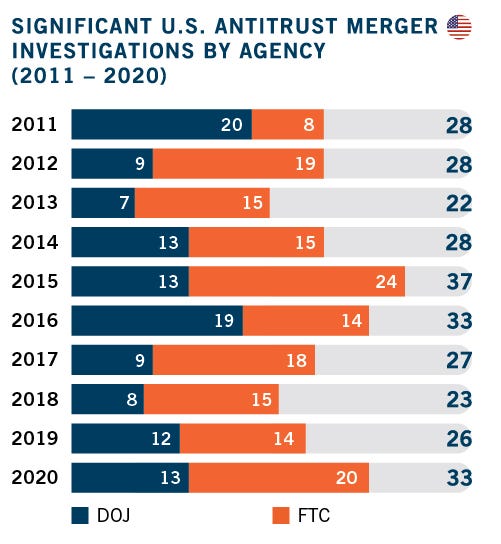
The U.S. numbers continue to show relative stability across Republican- and Democratic-led administrations in terms of the volume of significant merger investigations.
The DOJ and FTC concluded 33 significant U.S. merger investigations during 2020. This total matches the last year of the Obama administration and is behind only the DAMITT record of 37 significant investigations in 2015.
The data show that the FTC handled nearly twice the number of investigations as DOJ in 2020. The FTC completed 20 significant investigations, compared to 13 for DOJ.
Seven of the FTC’s significant investigations concluded in 2020 resulted in a complaint seeking to block the merger, compared to one for DOJ.
Overall, the Trump administration averaged about 27 significant investigations per year, slightly below the average of 30 in the Obama administration’s second term.
In 2020 the U.S. Agencies Filed the Highest Number of Complaints in the Last 10 Years Seeking to Block Mergers
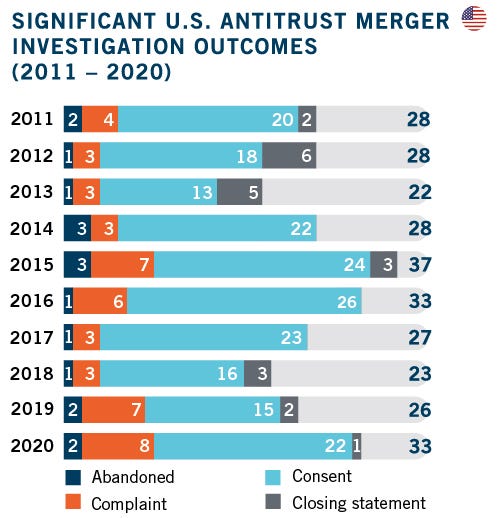
Contrary to some expectations for Republican-led administrations, the Trump administration was active in seeking to block mergers.
In 2020, the agencies filed eight complaints seeking to enjoin mergers at the conclusion of significant investigations, which is the highest annual total observed in DAMITT’s ten-year history. In addition, the antitrust agencies took credit for the abandonment of two significant investigations prior to the filing of a federal court complaint.
Overall, the agencies filed an average of 5.25 complaints per year during the Trump administration, with most of those complaints filed in the administration’s last two years.
By contrast, the agencies filed an average of 4.75 complaints per year during the Obama administration’s second term, also with the bulk of the complaints filed in the administration’s last two years.
Together, these results show some consistency in the number of challenges pursued across administrations, with a noticeable uptick over time and towards the end of each administration.
Significant Investigations of Mergers with Vertical Aspects Declined While Those with Nascent Competition Issues Increased in 2020
Despite the agencies’ introduction of new Vertical Merger Guidelines, the agencies only concluded one significant investigation with vertical aspects (i.e., significant investigations with at least one vertical allegation identified in the complaint, one vertical remedy in the consent decree, or one vertical issue mentioned in the closing statement) – London Stock Exchange/Refinitiv – in 2020. DOJ ultimately chose not to seek a consent decree or file a complaint to enjoin that acquisition. By comparison, the EU Commission required significant remedies from the companies when clearing the same transaction. This total of one significant merger investigation with vertical aspects in 2020 was down from three in 2019 and five in 2018.
At the same time, the agencies conducted significant merger investigations into seven transactions involving potential or nascent competition in 2020, an increase from five in 2019 and three in 2018. Given this notable increase over the last three years, we expect this focus on nascent competition to continue into 2021.
Number of Significant EU Investigations in 2020 Remains Steady at Its 2019 Level
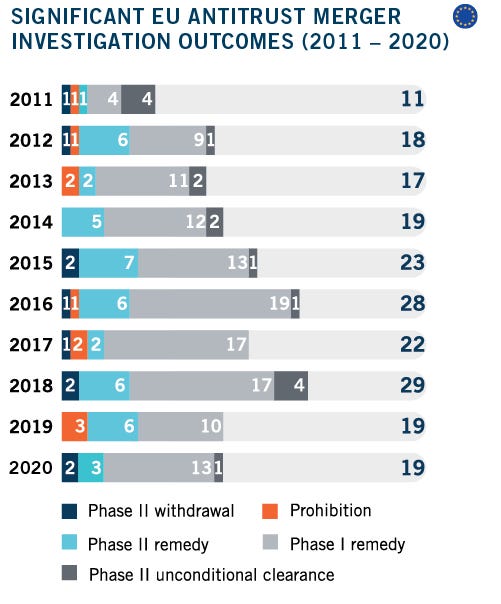
The EU Commission concluded 19 significant merger investigations in 2020, the same number as the previous year, which confirms that there has been a slowdown in activity relative to the very busy years in 2016 and 2018. The decrease observed in 2019 and 2020 in significant merger investigations may not be due to any slackening of enforcement intent but rather a function of the quantity and complexity of deals notified.
Sixteen significant merger investigations resolved in 2020 were cleared with remedies: three in Phase II and 13 in Phase I. Of the remaining Phase II resolutions, one was cleared unconditionally and two deals were abandoned.
After five years of continuous year-on-year increases in the number of notifications to reach an all-time high of 414 deals notified in 2018, 2020 continued the downward trend observed in 2019. The number of transactions notified in 2020 was 361, down five percent from 2019. It is, however, too early to tell if this decrease is due to cyclical fluctuations of M&A activity or related to the COVID-19 pandemic.
The EU Commission’s caseload is expected to decrease slightly in 2021 due to the expiry of the Brexit transition period. The UK will no longer count towards the EU jurisdictional thresholds and according to the EU Commission’s estimate there may be a reduction of up to 15 percent in the number of cases that qualify for review under the EU Merger Regulation. In contrast, the caseload of the UK Competition & Markets Authority (CMA), now a new standalone jurisdiction, is expected to increase by more than 50 percent.
Seventy-six percent of the cases resolved by the EU Commission in 2020 were assessed under the short-form/simplified procedure. The average duration of the EU Commission’s review of those short-form cases, measured from notification to decision, was 17.6 working days. This is considerably below the maximum Phase I review period of 25 working days. The revised simplified procedure has been one of the most successful features of the 2013 overhaul of EU merger control procedures, resulting in a significant reduction in the time it takes the EU Commission to review cases that do not give rise to substantive issues.
Average U.S. Merger Litigation Durations Rise to a New Record in 2020
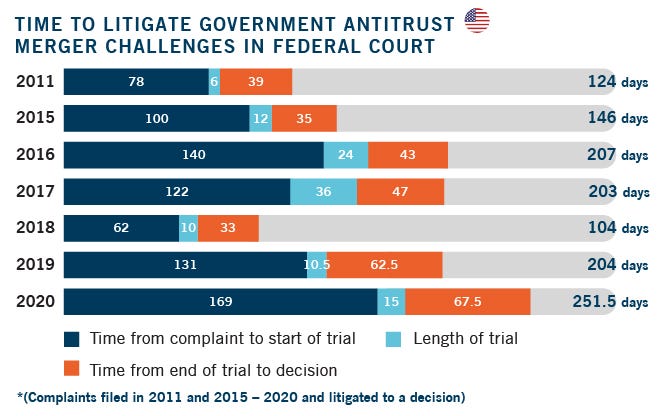
Although DAMITT does not show a significant impact of the pandemic on the duration of significant merger investigations, the pandemic appears to have had a more pronounced effect on the duration of merger litigations. Merger litigations filed in 2020 lasted longer than in any year tracked by DAMITT going back to 2011.
The FTC merger litigations filed against Peabody Energy/Arch Coal and Thomas Jefferson University/Albert Einstein Healthcare Network took considerably longer to get from the complaint to a trial decision than the FTC and DOJ merger trials for Evonik/PeroxyChem and Sabre/Farelogix filed in 2019. The average duration of 251.5 days for 2020’s merger cases blew past the prior DAMITT record of 207 days in 2016.
Complaints in both Peabody Energy/Arch Coal and Thomas Jefferson University/Albert Einstein Healthcare Network were filed in February 2020 shortly before the COVID-19 pandemic swept across the U.S. This timing may explain the longer than average durations of these proceedings in 2020.
Looking Forward to the Biden Administration
Despite the fanfare surrounding the change in any Presidential administration, DAMITT data show that any differences in enforcement policy between the Obama and Trump administrations were more marginal than major. We expect similar incremental changes under the Biden administration if the new appointees pursue merger enforcement policies consistent with the Obama/Biden administration.
Under the Trump administration, the U.S. agencies conducted 109 significant merger investigations between 2017 and 2020, slightly behind the 120 significant merger investigations in the last four years of the Obama administration. Despite fewer significant investigations overall, 21 of those significant merger investigations ended in complaints under the Trump administration, which is two more than the 19 complaints filed by the Obama administration in its second term.
Moreover, despite public commitments to reduce the duration of significant investigations, the Trump administration saw a 15 percent increase in average duration for its significant investigations between 2016 and 2020. While this was a somewhat lower rate of increase than the agencies saw in the second term of the Obama administration, it continued the trend towards longer durations for significant merger investigations.
The recent resignation of FTC Chairman Joseph Simons and the appointment of FTC Commissioner Chopra to be the Director of the Consumer Financial Protection Board opens the door for the Biden administration to appoint a new Democratic Chairman and at least one other new Democratic commissioner, which would flip control of the Commission to the Democratic side. Until then, however, the FTC will have a 2-2 split of Democratic and Republican commissioners absent any further resignations. This split is likely to result in a short-term continuation of the status quo because a majority is needed to authorize FTC litigations and approve consent orders. But assuming Biden appoints DOJ and FTC leadership similar to the group that served under the Obama/Biden administration’s second term, these policy differences would not be drastic once new leadership is fully installed.
At the same time, Democratic control of Congress raises the possibility of more substantial changes. The Democrat-led Congress may be more likely to pass antitrust merger reforms (e.g., by lowering the burden on the government to prove its case in merger litigation). Congress may also authorize greater agency funding for merger investigations. These changes, if implemented, likely would result in more merger enforcement.
Conclusion
While the circumstances of future antitrust-sensitive transactions may lead to results above or below DAMITT averages, 2020 statistics suggest that parties to the hypothetical average “significant” deal subject to review only in the U.S. would have to plan on 11-12 months for the agencies to investigate their transaction and another 8-9 months if they want to preserve their right to litigate an adverse agency decision.
Deal timetables for EU cases where the investigation is likely to proceed to Phase II need to accommodate an average lapse of 15 months from announcement to clearance, while Phase I deals expecting to be cleared with remedies now need to allow for nearly 10 months from announcement to clearance. With CMA becoming the new regulator on the block as of 1 January 2021, parties to deals with a UK nexus should carefully consider the merits of notification (which is not compulsory) and whether the CMA is otherwise likely to launch an own-initiative investigation.






